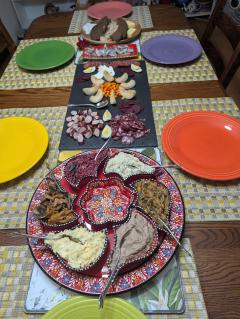 It started with a chance comment from my friend Bryan that his knowledge of food in the Slavic countries north of the Middle East was limited, and that as far as he knew the people of Russia silently starved. I was in the room, and our friend John Morse was there as well. As I prepared a reply, John quickly said that there a lot of really interesting Russian food and that Bryan and his wife should have a Russian feast at my house!
It started with a chance comment from my friend Bryan that his knowledge of food in the Slavic countries north of the Middle East was limited, and that as far as he knew the people of Russia silently starved. I was in the room, and our friend John Morse was there as well. As I prepared a reply, John quickly said that there a lot of really interesting Russian food and that Bryan and his wife should have a Russian feast at my house!
So I adjusted my reply from a somewhat dry anthropological review of Russian food ways to a hearty invitation while I mentally scanned the calendar and my opportunities to get to the right markets. I enjoy putting on these feasts, but they take planning and shopping, and the holidays were approaching. The Russian feast in particular has many components that are unfamiliar to western diners, so it can have great impact for culinary explorers if it's planned, supplied, prepared, and executed carefully.
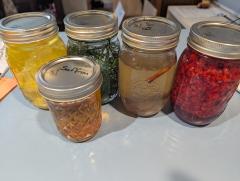 It took a few weeks, but we finally did it last night, 17 November 2024. Guests were Bryan Gregory and his wife Bridget, and our friends Don Nicholson and his wife Jen. Don and I have known each other for 25 years, but this was his first feast at our house.
It took a few weeks, but we finally did it last night, 17 November 2024. Guests were Bryan Gregory and his wife Bridget, and our friends Don Nicholson and his wife Jen. Don and I have known each other for 25 years, but this was his first feast at our house.
We had five courses:
- We opened with zakuski and vodka. Zakuski are little appetizers to open the meal, served with chilled vodka. I had made five infused vodkas in the Russian tradition, Saffron, Lemon, Dill, Pepper-Honey, and Cranberry, shown here.
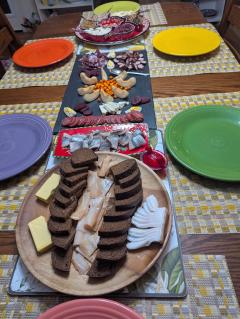 The zakuski are shown in the top photo and again here from both ends of the table.
The zakuski are shown in the top photo and again here from both ends of the table.
- The platter in the foreground has five salads and a chicken liver pate from Baza Gourmet Market in Newton: The paste is front right, then counterclockwise from there are Mangal eggplant salad, Forshmakt salad of apples and herring, a salad of beet and prune, mixed mushrooms, and a yellow cheese salad. The center cup eventually had yellow pike caviar that was still in the fridge when the photo was taken.
- The rectangular red plate had Matjes Herring.
- The center slate has three kinds of sausage, farmer's cheese, pickled beets, and pickled apples around some bright yellow Sea Buckthorn berries.
- The round board has black bread flanked by smoked butter on the left and salo (fine pork fat) on the right, with butterfish in the middle.
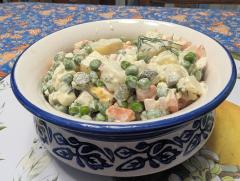 We lingered long over the zakuski and vodkas before moving on to the next course. We opened two Georgian wines and served a classic Salad Olivye made by Jen: diced root vegetables with peas, chopped cornichons, and other savories, a bit of ham, some dill, and a somewhat zesty dressing or a sort of mayonnaise with some of the pickle-juice from the cornichons. It was refreshing and delicious after the gustatory onslaught of the openers, and a great way to reset our taste buds for what was to come,
We lingered long over the zakuski and vodkas before moving on to the next course. We opened two Georgian wines and served a classic Salad Olivye made by Jen: diced root vegetables with peas, chopped cornichons, and other savories, a bit of ham, some dill, and a somewhat zesty dressing or a sort of mayonnaise with some of the pickle-juice from the cornichons. It was refreshing and delicious after the gustatory onslaught of the openers, and a great way to reset our taste buds for what was to come,- The wines were an Rkatsiteli dry Georgian white and a Kindzmarauli semi-dry Georgian red, both good examples of Georgia's 8,000 year old winemaking tradition. These were accompanied by a Kvass, a malty soft drink made from fermented black bread.
- After the salad we had a round of Pelmeni meat-stuffed dumplings in a bath of melted smoked butter.
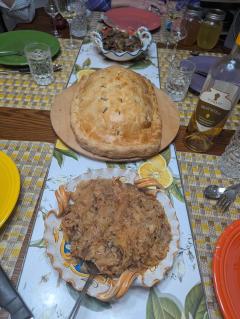 Then came the main course:
Then came the main course:
- In the foreground is Braised Sauerkraut with Bacon and Mushrooms, tender and savory, but not sour because the sauerkraut is rinsed and then braised slowly.
- In the middle is the celebrated Kulebiaka, an enormous pie of sour cream pastry filled with layers of dilled rice, sauteed chanterelle mushrooms, chopped hard-cooked egg, and salmon poached in white wine and fish stock, then dressed with a mixture of lemon juice and melted butter and baked until golden.
- At the back is a dish of mixed mushrooms sauteed with onion and then simmered with Madeira. This is sometimes mixed with sour cream, dill, and nutmeg, but I thought that would be too much considering what was already on the table.
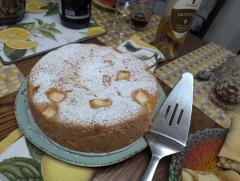 After the main course, we tucked into a classic apple sharlotka provided by Bridget and Bryan. The sharlotka is ubiquitous in Slavic countries; it's similar to a French clafoutis, a pan filled with pared, chopped apples and then surrounded with a light, eggy batter and baked.
After the main course, we tucked into a classic apple sharlotka provided by Bridget and Bryan. The sharlotka is ubiquitous in Slavic countries; it's similar to a French clafoutis, a pan filled with pared, chopped apples and then surrounded with a light, eggy batter and baked. - I supplemented this with a few cheese blintzes with birch syrup (like maple syrup but made from the sap of birch trees, which is also used to make the old New England favorite birch beer). The blintzes could not compete with the sharlotka but the birch syrup was interesting to try.
 It was a fun feast and it produced a lot of dishes to clean! It takes about three loads as packed as this one to catch up, but we have the machine so it's easy. At these dinners, the guests always offer to help clear the dishes and help with other clean-up, and we appreciate the offer, but doing a feast like this in our small kitchen is like playing trombone in a phone booth - there's just not enough room for everything and I end up stacking favorite dishes precariously, squeezing wine glasses at odd angles, and otherwise making everything fit in blatant violation of the laws of geometry, it's no place for civilians!
It was a fun feast and it produced a lot of dishes to clean! It takes about three loads as packed as this one to catch up, but we have the machine so it's easy. At these dinners, the guests always offer to help clear the dishes and help with other clean-up, and we appreciate the offer, but doing a feast like this in our small kitchen is like playing trombone in a phone booth - there's just not enough room for everything and I end up stacking favorite dishes precariously, squeezing wine glasses at odd angles, and otherwise making everything fit in blatant violation of the laws of geometry, it's no place for civilians!
In the end, Bryan accepted that if anyone was silently starving in the countries north of the middle east, it was not for want of a rich culinary tradition!
